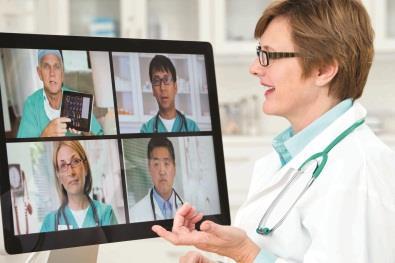How a video meeting link up between Jordan and an NHS England trust triggered a new approach to multidisciplinary collaboration in Yorkshire
It was the realisation that they could use modern technology to run a successful multidisciplinary team (MDT) meeting between Leeds and Jordan that was the real light bulb moment for Geoff Hall.

The lead cancer clinician for Leeds Teaching Hospitals Trust and his colleagues, asked a perfectly reasonable question: if they could link up with Jordan, why could they not link up local hospitals across Yorkshire?
But a year ago, the technology at the trust’s cancer centre - a tertiary referral unit providing and coordinating care for cancer patients across the Yorkshire and Humber region - simply was not up to the job.
This meant that clinicians from across the network had to travel many miles to take part in MDT meetings to discuss and decide on care and treatment of their patients. This put strain on staff, workforce planning, and transport budgets.
“Leeds Cancer Centre was a new build in 2008 with technology to match,” says Dr Hall. “We were relying on telephone lines and ISDN and all that means in terms of dropped calls, jumpy video and a very poor quality experience overall. It really had to change.”
A little over a year ago, the cancer team, based at St James’s University Hospital in Leeds, approached trust deputy director of informatics Eileen Jessop to ask for help. She could see the case for change. “People were having to spend a lot of time travelling to other locations,” she says. “The equipment was unreliable. The video didn’t work. Clinicians were working long days - from 8am to 7pm and maybe having to deal with 80 cases - it wasn’t going well.”
‘We were relying on telephone lines and ISDN and all that entails in terms of dropped calls and jumpy video’
Ms Jessop and Dr Hall worked up a business case and persuaded their managers that it was a good idea to transform the area, to make it fit for the MDT in the 21st century.
At that point, another factor came into play. The trust had a partnership with the King Hussein Cancer Center in Jordan and wanted to see if it could run an MDT meeting between the two countries. The partnership came about, explains Dr Hall, because the Middle Eastern facility wanted to work with one of the world’s top cancer units. It turned to the UK partly because of practical reasons - the time difference is less than with the US, for example - but also because Leeds is a major cancer centre with an international reputation.
It was in everyone’s interests to make the collaboration work, but the lack of decent technology was potentially a major barrier.

So Ms Jessop approached technology company Cisco, with whom the trust already had a relationship, to see if they could lend the equipment necessary for this international MDT meeting.
“Within a month and a half we had the MDT equipment in that room and ran a live MDT meeting. Then, of course, people were asking why could we make this work for Jordan and not for Airedale, for example,” she says.
The same point struck Dr Hall, who also saw the potential for transforming the way that cancer services worked across Yorkshire and the Humber. “We realised how far technology had come, and what it could do to support the whole process,” he says.
“We wanted to look at the art of the possible. We were hugely impressed by what was possible in the way of video conferencing: it really brought a new reality to face to face contact.” The next stage involved drawing up a business case, explains Ms Jessop. Clearly, the case was a persuasive one and the investment was found to upgrade the trust’s technology.
“We put a tender out and awarded it to Cisco, through Block Solutions, our network provider. It involves infrastructure that allows the trust to grow the teleconferencing facilities across the organisation.”
‘We could have conversations as far east as Hull and west as Calderdale’
Essentially, the upgrade has involved installing state of the art communications equipment, giving comprehensive video and microphone coverage. This means that whatever happens in a room can be seen and heard by partner organisations, almost as if they were there. It is a far cry from the dropped calls and jerky video of the past.
Three rooms have been set up and they work remarkably successfully, Ms Jessop says. “People can walk around the room and be seen and heard very easily, and the quality is good. In fact, it’s fantastic,” she says. The system involves microphones in the ceiling tiles and cameras that cover the room. “Wherever you go, the cameras will follow you and you can still be heard.
“And it’s being actively maintained - if something goes wrong then there’s one number to call and it gets fixed.”
The way the new system actually works is that a list of patients to be reviewed by the MDT is drawn up in collaboration with partner organisations ahead of the calls. All members of the team also have access to notes, images and results. In terms of saving clinician time, it is a real winner, she says. “This takes the place of someone having to get into a car and drive to another part of the region.”
The collaborating organisations need simple video technology at their end - essentially a camera and a microphone, and the team works with them to make sure they have the right equipment and are comfortable with the process.
Ms Jessop says that the system makes the region feel much smaller. “We could have conversations as far east as Hull and west as Calderdale,” she says.
“We want to do a benefits review, but the feedback so far has been really positive. People have been looking for something like this for so long. It’s made a huge difference.”
Sense of optimism
Dr Hall is a big believer in using technology to support the patient to have the best possible experience - rather than trying to shoehorn patients’ needs into what existing equipment and working practices dictate.
That translates well to the current initiative, in as much as it makes it possible for patients to be treated nearer to home, while their care is organised at a regional level with all the specialist expertise this involves. “If you think about it, for so many things, you need to move the data, not the patient,” he says.
“I had a sense of optimism about this. I’m a technophile and was confident that the technology would help us work in new ways.” He believes that colleagues came on board partly because they were using technology in their own lives, and knew how much it had advanced. Translating that to a work situation did not seem too much of a stretch. “We’re used to running four-way Skype calls with people around the world, yet we couldn’t do a video conference with Bradford,” he recalls.
‘We were used to running international four-way Skype calls, yet we couldn’t do a video conference with Bradford’
The new system took three months to install, he says - and he is very happy with the results.
“Now we have an MDT [meeting] where we can have contact with any one of six district general hospitals,” he says. “We can share images from radiology, test results, and everything else we need to plan care for patients.”
These “hard” clinical documents and images, though important, are not the only advantage of the new system. The real beauty of it, according to Dr Hall, is that you can get a sense of what people are thinking in a way that would not be possible with a telephone conference, for example.
“Facial expressions are important,” he says. “You can be discussing or proposing something and you see the specialist nurse is shaking her head - she knows that particular patient has dementia, for example, and lives on their own, and simply won’t be able to cope with that treatment. That’s incredibly valuable.”
He hopes that, in the future, the technology might be used to bring in a third party (at the moment the meetings are between Leeds and one other partner at a time). This brings the exciting possibility of involving the GP or potentially even the patient.
And Dr Hall sees other possibilities too. “Cancer is not unique in the need to bring multiple disciplines together,” he says.
“In a hospital the size of this [one], the ability to video conference face to face is valuable, but that’s not unique to cancer. Technology like this is transforming the way we deliver healthcare.”
Special report: Adopt team tactics

To help multidisciplinary teams deliver better care
- 1
- Currently reading
Special report case study: 'Why not here?'





























No comments yet